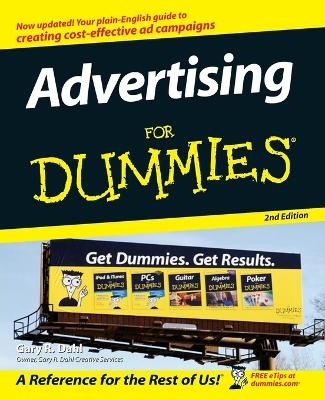
Advertising For Dummies
For Dummies (Verlag)
978-0-470-04583-1 (ISBN)
So, you need to create an advertising campaign that brings in more customers, adds more dollars to your bottom line, and validates all the reasons you went into business in the first place. But how can you make your ad look and sound like champagne if your budget can only afford beer? Are you wasting your time trying to sell ice to an Eskimo? The world of advertising can seem like a daunting place—but it doesn’t have to be. Advertising for Dummies coaches you through the process and shows you how to:
Identify and reach your target audience
Define and position your message
Get the most bang for your buck
Produce great ads for every medium
Buy the different media
Create buzz and use publicity
Research and evaluate your competition
Advertising for Dummies offers newbies a real-world look at the ins and outs of advertising—from online and print to TV, radio, and outdoor formats—to show you how you can easily develop and execute a successful campaign on any budget. Plus, you’ll find a glossary of common buzzwords you may encounter along the way so you can talk the talk like the advertising guru you (almost) are! With simple tips on how to write memorable ads and timeless lessons from the legends, this book is packed with everything you need to have people from New York to Los Angeles whistling your jingle.
Gary Dahl is an award-winning copywriter, creative director, and advertising agency owner in California's Silicon Valley. He is also the creator of the sensational Pet Rock.
Introduction 1
About This Book 1
Conventions Used in This Book 2
What You’re Not to Read 2
Foolish Assumptions 2
How This Book Is Organized 3
Part I: Advertising 101 3
Part II: Creating Great Ads for Every Medium 3
Part III: Buying the Different Media 4
Part IV: Beyond the Basics: Creating Buzz and Using Publicity 4
Part V: The Part of Tens 4
Icons Used in This Book 5
Where to Go from Here 5
Part I: Advertising 101 7
Chapter 1: Advertising: Mastering the Art of Promotion 9
Making Advertising Work 10
Getting to Know Your Media Options 11
Regarding radio 11
Rating TV 12
Contemplating print 12
Musing upon direct mail 13
Scrutinizing outdoor advertising 14
Ogling online ads 14
Poring over publicity 14
Lessons from the Legends: Figuring Out Your Advertising Needs 15
David Ogilvy 16
Bill Bernbach 17
Wieden and Kennedy 18
Chapter 2: Setting and Working within Your Advertising Budget 19
Determining How Much You Can Afford to Spend 20
Developing an Advertising Strategy and a Tactical Plan 22
Researching and evaluating your competition 22
Identifying your target market 23
Knowing your product’s appeal 24
Maximizing Your Budget 24
Getting the most out of your creative and production 25
Using media you can afford 26
Chapter 3: Boosting Your Budget with Co-Op Programs 33
Knowing Who Uses Co-Op Funds 33
Finding Out Which of Your Suppliers Have Co-Op Funds Available 35
Knowing who to talk to 36
You’ve found your funds, now how do you get the dough? 37
Understanding the Rules, Regulations, and Restrictions 37
Getting your ads preapproved 38
Obtaining proof of performance 39
Submitting your co-op claims package 40
Chapter 4: Defining and Positioning Your Message 41
Understanding Why People Choose One Product or Service over Another 42
Image is everything 42
You’ve got personality! 42
Convenience: More than location 43
Don’t sacrifice service! 44
Let ’em know your uniqueness 45
The price is right 45
Researching and Assessing Your Competition: What Sets Your Product Apart? 46
Developing a Strategy for Your Advertising Campaign 48
Case Study: Advertising a Chain of Women’s Plus-Size Clothing Stores 49
Identifying the USP: The unique selling proposition 50
Knowing the budget — and staying within its limits 50
Shooting the ads 51
Selecting the right media 51
Applying these ideas to your ad campaign 52
Chapter 5: Forming an Effective Ad Campaign 53
Identifying and Targeting Your Audience 54
Focus on your primary market 55
Research your market 55
Checking Out Your Competition’s Ads so You Can Differentiate Yours 56
Focusing on Ads That You Respond to Most 57
Concocting a Creative Hook to Get Your Audience’s Attention 59
Creative brainstorming 60
Creative example: Developing a campaign for a community college 62
Incorporating Your Creative Message into an Overall Media Ad Campaign 65
Ensuring consistency of your message in all media you choose 66
Keeping your message simple 66
Using words that sell 67
Delivering your message with clarity 69
Part II: Creating Great Ads for Every Medium 71
Chapter 6: Online Advertising: Maximizing the Enormous Reach of the Internet 73
Measuring the Pros and Cons of Online Advertising 74
Creating Your Own Web Site 76
Deciding on your Web site goals 77
Choosing an effective domain name 78
Saving money (or your sanity): Your Web design 78
Designing a strong Web site 79
Promoting Your Site 83
Setting Goals for Online Ads 85
Ads that build awareness 86
Ads that encourage click-through 86
Ads that encourage sales 87
Choosing Among Online Ad Formats 87
Creating banner ads 88
Doing e-mail advertising 92
Chapter 7: Using Print Ads: Small Spaces with Big Audiences 95
Exploring the Advantages of Print 95
Recognizing What Makes a Print Ad Successful 96
Writing and Designing an Eye-Catching Print Ad 99
Hammering out your headline 99
Shaping your subheads 101
Building your body copy 101
Generating your graphics 102
Don’t forget the layout! 103
Chapter 8: Radio: Effective, Affordable, and Fun 107
Summarizing Your Business in 60 Seconds 107
Who are you? 108
What are you selling? 108
When do you want consumers to act? 109
How can customers get in touch with you? 109
Why should customers hire or buy from you? 110
Deciding on the Format for Your Ad 112
Talking it up: Dialogue 112
Amusing (and schmoozing) the masses: Comedy 113
Giving just the facts: A straight read 114
Determining Who Should Read the Script 115
Doing it yourself 115
Using a studio announcer 118
Hiring a professional voice talent 118
Setting It All in Motion: How to Get Your Ad on the Radio 120
Chapter 9: Demystifying TV Commercials: They Don’t Have to Win Awards to Be Effective 123
Designing Your TV Commercial in Layers 124
Audio 124
Video 125
Computer graphics 125
Bringing the Audio and Visual Together 126
Deciding What to Feature in Your Commercial 129
Appearing in your own commercial 129
Promoting with a professional 130
Highlighting your place of business 130
Focusing the camera on your product or service 131
Figuring Out Where to Shoot 131
On location 131
In the studio 134
Producing Your Commercial 135
Using the TV station’s production department 135
Hiring an independent production house 137
Editing Your Commercial 137
Chapter 10: Collateral Advertising and Direct Mail: Brochures, Flyers, Newsletters, and More 139
First Things First: Planning Your Collateral Campaign 140
Watching Out for Collateral Budget Busters 141
Adding a little (or a lot) of color 142
Printing cheap: No such thing? 142
Designing the Best Collateral Ads for Your Business 145
Striving for a simple design and clear copy 146
Deciding what to include in your ad 147
Getting help with your design 151
Handing Off the Dirty Work: Direct-Mail Houses 154
Asking the direct-mail provider some important questions 154
Planning your postage 157
Chapter 11: Opting for Outdoor Ads: Billboards, Posters, Ads on Buses, and Other Signage 159
Recognizing the Advantages of Outdoor Advertising 160
Measuring the Effectiveness of Outdoor Ads 162
Choosing Among Your Outdoor Advertising Options 163
Designing Memorable Outdoor Advertising 166
Pursuing potential customers 167
Making your ad readable 168
Keeping your ad clear 169
Making it worth remembering 169
Looking at a Success Story: Chick-fil-A’s Billboard Campaign 170
Aiming for the target audience 171
Setting up the marketing strategy 171
Capitalizing on the creative strategy 171
Reaping the results 171
Part III: Buying the Different Media 173
Chapter 12: Investing in Internet Advertising 175
Hiring Someone to Create Your Business Web Site 176
Choosing a Web designer worthy of your hard-earned dollars 176
Contracting with and paying a Web designer 178
Finding an ISP to Run Your Site 179
Ranking Your Site: Purchasing Key Words on Search Engines 181
Buying Banner Ads on Other Web Sites 181
Using ad networks 181
Placing your online ads yourself 182
Online advertising via affiliate programs 182
Finding out whether your banner is working 183
Assessing the Cost-Effectiveness of E-Mail Advertising 184
Chapter 13: Buying Ad Space in Print Media 187
Choosing the Right Publication for Your Print Ad 188
Calculating Your Print Ad’s Cost 189
Finding a Good Sales Rep 191
Cold-calling a publication: Don’t do it! 191
Going straight to the top: Call the sales manager 192
Asking for referrals 192
Becoming a Formidable Ad Buyer 193
Acting as though you’re reluctant 193
Making your sales rep think she’s got competition 195
Complaining when the time is right 196
Chapter 14: Purchasing Ad Time on the Radio 199
Determining the Best Radio Station for Your Ads 200
Specifying which demographic you’re after 201
Doing your homework 202
Buying the station 204
Talking the Talk of Radio Advertising 205
Cume 206
Ranker 206
Dayparts 207
Reading the Fine Print 207
Hammering out the details 207
Holding ’em to it 209
Waiting Patiently for the Results 210
Giving your audience time to respond 210
Buying radio time: Too little, too much? 211
Evaluating your radio ads from time to time 211
Taking Advantage of Seasonal Incentives to Reduce Your Costs 212
Chapter 15: Getting Your Ads on Television 215
Buying the Programming, Not the Station 216
Comparing TV Stations: Request Media Kits 217
Ready to Negotiate? Better Know Your TV Marketing Terms First! 218
Understanding timing and sweeps 219
Measuring ratings and market shares 219
Working with a Sales Rep 221
Talkin’ the talk: Negotiating successfully 223
Is Cable Advertising Right for You? 226
Working effectively with a cable sales rep 227
Hitting the bull’s-eye with cable ads 229
Doing the math: Cable TV market penetration 229
Chapter 16: Deciding Whether to Hire an Ad Agency 233
Determining When You May Need to Hire an Agency 234
Finding the Right Agency for Your Business 236
Getting to Know the People Handling Your Account 237
Compensating Your Agency 238
Media commissions 239
Creative and production charges 240
Markups 241
Retainers 241
Working with Your Agency to Get What You Need 242
Part IV: Beyond the Basics: Creating Buzz and Using Publicity 245
Chapter 17: Creating Buzz and Word-of-Mouth Advertising 247
Getting the Terminology Straight 247
Seeing the Power of Word of Mouth 248
Examining word-of-mouth marketing success stories 249
Beware of negative buzz! 250
Tips and Techniques on Generating Buzz 251
Coining a great new phrase 251
Hiring beautiful people to promote your product 251
Taking advantage of celebrity endorsements 252
Throwing a party 253
Hitting the streets 253
Figuring out where to find your big mouths 254
Creating a blog about your business 254
Chapter 18: Leveraging Your Advertising with Public Relations, Publicity, Specialty Items, and Events 257
Starting a Public Relations Campaign 258
Understanding How Publicity Can Bring Customers 259
Writing an effective press release 260
Getting the story to the right media 263
Advertising on Specialty Items 266
Recognizing the advantages of specialty advertising 267
Selecting specialty items with a purpose 269
Keep the copy simple on a specialty item 271
Generating Traffic: Promotional Events 271
Radio: The promotions king 272
Other promotional opportunities 275
Participating in Sponsored Events 275
Determining whether you can staff the event 276
Calculating the costs: A valuable investment? 277
Deciding which events are worthwhile 277
Finding sponsored events that work for your business 278
Part V: The Part of Tens 279
Chapter 19: Ten Secrets for Writing Memorable Advertising 281
Ignoring the Rules of Grammar 281
Making Your Ads Effective 282
Knowing Why People Buy Your Products 282
Finding a Creative Hook 283
Remembering That Creativity Is Hard Work 284
Letting Your Creative Hook Dictate Your Media Buy 284
Considering Your Budget 285
Striving for Continuity 285
Keeping It Simple 286
Being Clear in Your Message 286
Chapter 20: (Almost) Ten Ways to Know It’s Time to Hire an Agency 287
Your Ad Budget Has Become Substantial 287
You Need the Expertise of a Professional Media Buyer 288
Your Creative Light Bulb Has Burned Out 288
You’re Overwhelmed by the Demands of Production 289
You’re Having Trouble Keeping Up with the Bookkeeping 289
You’re Leaving Co-Op Funds on the Table 289
Your Time Is Being Taken Up by Media Reps 290
You’re Running Faster to Stay in the Same Place 290
You Want a Bunch of Free Stuff 291
Glossary 293
Index 297
| Erscheint lt. Verlag | 12.1.2007 |
|---|---|
| Sprache | englisch |
| Maße | 185 x 231 mm |
| Gewicht | 590 g |
| Einbandart | Paperback |
| Themenwelt | Sachbuch/Ratgeber ► Beruf / Finanzen / Recht / Wirtschaft ► Wirtschaft |
| Wirtschaft ► Betriebswirtschaft / Management ► Marketing / Vertrieb | |
| ISBN-10 | 0-470-04583-3 / 0470045833 |
| ISBN-13 | 978-0-470-04583-1 / 9780470045831 |
| Zustand | Neuware |
| Informationen gemäß Produktsicherheitsverordnung (GPSR) | |
| Haben Sie eine Frage zum Produkt? |
aus dem Bereich


